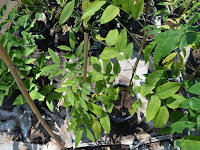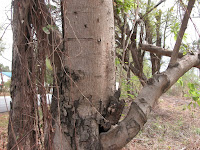Siam White is a natural hybrid between Cassia fistula and Cassia bakeriana
Origin: Thailand
Scientific name (Hybrid): Cassia fistula x Cassia bakeriana
Common names:
Siam White (English) named by the author
คูนขาวไทย (Koon Khao)
วัชรพฤกษ์ (Vajrapruk) named by Surawit Wannakrairoj (former Department Head, Horticulture Department, Kasetsart University)
Original Tree Location: route # 3302, Tumbon Than Kasem, Phra Phutthabat district, Saraburi province in central Thailand
Link to google map:
Origin and its History
In the year 2002, I visited this tree located on a local road in Saraburi, Thailand. At the time, the tree was probably 10-15 years old with the height of about 10 meters. It was intended to plant as a street tree since it was in the same row of other Cassia fistula of about the same size. The tree was covered with long pendulous racemes of flowers which is a characteristic unique to Cassia fistula but with white flowers (with exceptional large in size) and with extra-long dark brown ripe seedpods (the longest ones known to Cassia). When the seedpods are young, they are burgundy in colour with narrow lime green stripes on two longitudinal indehiscence (grooves and ridges areas) zones running along the fruits length. The bi-colours in young seedpods is a characteristic unique to Cassia bakeriana.
The tree has been likely discovered by a few local people years before my visit. Many years later, the tree has become popular and has been extensively propagated and sold in plant markets in Thailand and finally exported to a number of countries as either a variant of Cassia fistula or Cassia x nealiae 'Queen's Hospital White', a tree from Hawaii. Most Thai collectors and growers called it "Koon Khao" which means White Cassia in English.
In 2019, DNA testing confirmed that the tree was a hybrid of Cassia fistula and Cassia bakeriana. The result from the DNA study is also in agreement with the previous morphological study. The hybrid shares some characteristics of both species. The finding clearly indicated that the hybrid is neither a variant of Cassia fistula nor a Cassia x nealiae 'Queen Hospital White' from Hawaii. This new Cassia was then named "Siam White" Cassia by the author to honor the country of origin which is Thailand.
Description
Tree and Trunk:
Tree: small tree to 15 m in height, deciduous or semi deciduous; Trunk: gray and smooth
 |  |  |
Twigs and Leaves:
Twigs: hairy when young, less hairy when mature
Leaves: pinnately compound, alternate, to 26 cm long; Stipules, scaly, paired with one on each side of leaf base, tiny, nonpersistent. Leaflets: 3-9 pairs (mostly 6), opposite, pubescent, dull green; petiolule, 4 mm long; leaflet size 8.0-12.5 cm long and 4.5-5.5 cm wide; leaflet shape, ovate to elliptic; leaflet apex, acute; leaflet base, obtuse
 |   |
Inflorescence and Flower:
Figure 3. Inflorescences and flowers, blooms from March to April/early May
Figure 4. Large and long pendulous recemes of flowers (left) and flower buds with off-red sepals, yellow petals, off-red pedicels and bracts (middle), and the parts of a flower (right), 5 petals (A), 5 sepals (B), pedicel (C), pistil (D), 3 long curved stamens with nodules in the middle (E), 4 short stamens (F), and 3 reduced stamens or staminodes (G)
Figure 5. Three maturation stages of flowers, flower size 90 mm across, starts with yellow (left) fading to light yellow (middle) and finally nearly white (right). Stamens disappear with age but pistil remains with the flower.
Figure 7. Ripe blackish brown seedpods to 110 cm in length (left and middle), and shiny brown seeds (right)
Figure 8. Seedlings of Siam White with various shape and size of leaflets (left), a Siam White seedling with pinkish flower (middle and right). As a hybrid, Siam White is not true from seeds. (Picture courtesy of Jessica Cabrera)
Figure 9. Tree trunks of Cassia fistula (left), Siam White (middle) and Cassia bakeriana (right)
Figure 10. Leaves and leaflets of Cassia fistula (left), Siam White (middle) and Cassia bakeriana (right)
Figure 11. Inflorescence and flowers - Cassia fistula (left), Siam White (middle) and Cassia bakeriana (right)
Figure 12. Inflorescences (left), flowers (middle), flower buds, calyxes and pedicels (right) in comparison
Figure 16. Cassia 'Siam White' with swollen nodule in the middle of its filament (left), Cassia fistula with no swollen nodule (middle), and young seedpods of C. fistula with totally green but those of Siam White with bi-colours (burgundy with lime green stripes) (right)
Figure 17. Inflorescences of Cassia fistula and Siam White (left), calyxes of C. fistula (green in colour) and Siam White (off-red in colour) (right)
Inflorescence: pendulous racemes to 50-55 cm long and 8-10 cm in diameter, borne along the branches; peduncle and rachis, off-red; pedicels, off-red, 62 mm long; bracts, off-red, tiny, nonpersistent
Flowers: size to 90 mm across; Sepals 5, off-red, 10 mm long; Petals 5, 30-35 mm long, yellow during flower bud stages to light yellow in fully open flowers then fading to almost white in aged flowers; Pistil 1, curved, off-red but green near the base, 30 mm long; Stamens 10, yellow, three long, 30 mm long, sigmoidally curved filament with a swollen nodule in the middle, four short, 20 mm long, three reduced to staminodes, 10 mm long; Flowering from late February/March to April/early May; fragrant
 |  |  |
 |  |  |
 |  |  |
Seedpods:
Pods: pendulous, cylindrical, indehiscent, to 110 cm long, 15-18 mm in diameter; Young seedpods, bi-colours (burgundy on fruit's body (divalve) and narrow lime green stripes on two longitudinal indehiscent zones (replum or grooves and ridges areas) along the seedpod length, hairy (pubescence); Ripe seedpods, totally dark brown and less hairy; Seedpods ripen by January to February; Seeds, in slightly sticky dark brown pulp, approximately 90 seeds per a seedpod, ellipsoid, glossy brown
Most of the time, hybrids are less fertile than its parents, but there have been some instances where hybrids are more fertile and Siam White is one of them. Siam White bares numerous seedpods with large number of fertile seeds. Young seedpods of Siam White are bi-colours, a similar characteristic found in C. bakeriana which is one of its parents.
Figure 6. Young seedpods with unique bi-colours, burgandy on fruit's body with lime green stripes on both sides of the fruit (left and middle), and maturing seedpods (right)
 |  |  |
 |  |  |
Siam White and its parents (Cassia bakeriana and Cassia fistula) in comparison
Trunk Color:
C. fistula: gray
Siam White: gray
C. bakeriana: pale gray
  |  |
Leaves and Leaflets:
C. fistula: young shoot, slightly hairy; Leaflets 3-8 pairs (mostly 5), smooth when mature
Siam White: young shoot, hairy; Leaflets 3-9 pairs (mostly 6), slightly hairy when mature
C. bakeriana: young shoot, very hairy; Leaflets 5-10 pairs (mostly 8), hairy when young and mature
 |
Inflorescence and flowers:
C. fistula: pendulous racemes 20-45 cm long; flowers, size 50 mm across; green calyx and pedicel; filaments with no swollen nodules; pistil, green; blooms from March to April
Siam White: pendulous racemes to 55 cm long; flowers, size 90 mm across; off red calyx and pedicel; filaments with swollen noodles; pistil, green to off-red; blooms from late February/March to April/early May
C. bakeriana: lateral racemes to 20 cm long; flowers, size to 90 mm across; deep red calyx and pedicel; filaments with swollen nodules; pistil, red; blooms from February to early April
 |  |  |
 |  |  |
Seedpods and seeds:
C. fistula: seedpods 30-60 cm; long, smooth, totally green when young, turning blackish brown when mature; seed in sticky black pulp; seedpods mature by January to February
Siam White: seedpods to 110 cm long, hairy, bi-colour (burgundy with two narrow lime green stripes) when young, turning dark brown and less hairy when mature; seed in slightly sticky dark brown pulp; seedpods mature by January to February
C. bakeriana: seedpods 30-50 cm long, very hairy, bi-colour (burnt brown with two narrow light green stripes) when young, turning dull dark brown when mature, covered with thick hairs; seed in unsticky yellow pulp; seedpods mature by December to January
Siam White is not Cassia x nealiae 'Queen's Hospital White'
Siam White is a hybrid of Cassia fistula and Cassia bakeriana (Based on DNA study in 2019). Therefore, Siam White is not Cassia x nealiae.
Queen's Hospital White has been reported as a hybrid of Cassia fistula and Cassia javanica. DNA study in 2019 revealed that C. fistula is one of its parents but C. javanica subsp. javanica is not the other parent.
DNA study clearly indicated that Siam White and Queen's Hospital White share only one of the parents which is C. fistula. Below are a few major differences of these two hybrids.
Key differences
Siam White:
Hybrid - Cassia fistula x Cassia bakeriana
Scientific name - Cassia x siamensis (proposed scientific name)
Calyx colour - off red
Young seedpod colour - pubescence and bicolor (burgundy with lime green stripes)
Young seedpod colour - pubescence and bicolor (burgundy with lime green stripes)
Queen's Hospital White:
Hybrid - Cassia fistula x Cassia javanica (probably either C. javanica subsp. nodosa or C. javanica var. indochinensis).
Scientific name - Cassia x nealiae
Calyx colour - green
Young seedpod colour - totally green and smooth
Young seedpod colour - totally green and smooth
Siam White is not a variant of Cassia fistula
In nature, the flowers of Cassia fistula are generally yellow in colour but may vary from deep yellow to light yellow to almost white from a tree to another. The C. fistula with white flowers may sometimes confused with the Siam White Cassia. Below are the key differences that can be used to distinguish these two Cassias.
Key differences
Siam White:
Calyx colour - off red
Pistil colour - off red but green near the base
Swollen filament - swollen nodule in the middle
Young seedpod colour - pubescence and bi-colours (burgundy with lime green stripes on opposite sides)
C. fistula:
Calyx colour - green
Pistil colour - green
Swollen filament - no swollen nodule in the middle
Young seedpod colour - smooth and totally green
 |  |  |
 |  |











